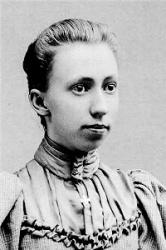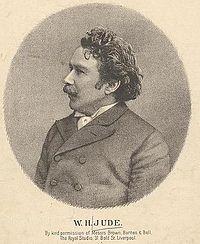Planning worship?
Check out our sister site, ZeteoSearch.org,
for 20+ additional resources related to your search.
- |
User Links
Person Results
‹ Return to hymnal






Export as CSV
Grace B. Maxwell
Person Name: G. B. M. Hymnal Number: 82 Author of "I Know Not When" in Hymns and Spiritual Songs Number Two
Grace B. Maxwell
Pauline Gilmour Hatch

1871 - 1955 Person Name: M. Pauline Gilmour Hymnal Number: 140 Composer of "[Volunteers are wanted! hear the stirring call]" in Hymns and Spiritual Songs Number Two Born: April 3, 1871, Cape May, New Jersey.
Hatch was the only daughter of Henry L. Gilmour. She showed a love for music at an early age, which was encouraged and cultivated in a musical atmosphere. William J. Kirkpatrick was her first instrumental teacher. She later received a diploma from the South Jersey Institute, Bridgeton, New Jersey, and also took a course at Richard Zeckwer’s Conservatory of Music in Philadelphia, Pennsylvania. She married H. Morgan Hatch of Delair, New Jersey, October 30, 1903.
Sources--
Showalter, p. 276
Music--
GO FORWARD
JESUS, REFUGE OF MY SOUL
OUR DEARLY LOVED BANNER
PEACE HYMN OF NATIONS
VOLUNTEERS, TO THE FRONT
© The Cyber Hymnal™ (www.hymntime.com/tch)
Pauline Gilmour Hatch
Eliza H. Hamilton
Hymnal Number: 150 Author of "Take Me as I Am" in Hymns and Spiritual Songs Number Two
Eliza H. Hamilton
Simeon Butler Marsh
1798 - 1875 Person Name: S. B. Marsh Hymnal Number: 171 Composer of "MARTYN" in Hymns and Spiritual Songs Number Two Simeon Butler Marsh USA 1798-1875. Born at Sherburne, NY, he was raised on a farm. A Presbyterian, he became a gifted organist and teacher. He sang in a choir at age seven and studied music at age 16. By age 19 he was teaching in the local singing schools in Geneva, NY, and had met hymnist, Thomas Hastings from Geneva, NY, who gave him much encouragement. He married Eliza Carrier, and they had a son, John, and a daughter, Jane. In 1837 he became publisher of the Amsterdam, NY, paper “Intelligencer” (later called ‘Recorder’), and ran it for seven years, even setting his own type. He moved back to Sherburne and founded the Sherburne News. He taught music to choirs and children for almost 30 years in and around the Albany Presbytery, and also served as a Sunday school superintendent for six years and a choir leader for three years. He set type for three juvenile books as well. For thirteen years he gave free music instruction to students in the Schenectedy area. In 1859 he returned to Sherburne and gave music instruction to large classes of men, women, and children. He wrote two cantatas: “The Savior” and “The king of the forest”. He wrote a number of hymns, but most have not survived over time. His wife died in 1873. He died at Albany, NY, and is buried in Schenectady, NY.
John Perry
Simeon Butler Marsh
Ira B. Wilson

1880 - 1950 Hymnal Number: 3 Composer of "[I have a dear Saviour Who loves me, I know]" in Hymns and Spiritual Songs Number Two Ira Bishop Wilson, 1880-1950
Born: September 6, 1880, Bedford, Iowa.
Died: April 3, 1950, Los Angeles, California.
Buried: Forest Lawn Memorial Park, Glendale, California.
Pseudonym: Fred B. Holton.
Wilson’s sister taught him to play the violin and organ while still at home. Around 1902, Ira began studies at the Moody Bible Institute in Chicago, Illinois. In 1905, he went to work for the Lorenz Publishing Company in Dayton, Ohio. His compositions appeared in The Choir Leader and The Choir Herald; he also served as editor in chief of The Volunteer Choir.
His works include:
The King’s Message, with Edmund Lorenz (New York: Lorenz Publishing Company, 1910)
The Beginners’ Choir, with Edmund Lorenz (Dayton, Ohio: Lorenz Publishing Company, 1911)
Praise Ye, a Collection of Sacred Songs, with Edmund Lorenz (New York: Lorenz Publishing Company, 1913)
His Worthy Praise, with Edmund Lorenz (Dayton, Ohio: Lorenz Publishing Company, 1915)
Sources--
Hall, pp. 413-5
Lyrics--
Go Forward to Conquer
Look Above
Make Me a Blessing © 1924
My Savior’s Voice
This Wonderful Christ Is Mine
Trustingly Follow
Music--
Across the Templed Hills
Angels’ Chorus, The
Christ Is Born
Christ the Lord Is Born
Christmas Lullaby
Conchita
Exalt the King
Give Praise
God Is Goodness, God Is Love
God Is So Good
He Arose Today
His Love Is Always True
Jesus Wants Us to Help
Joy to the World
Loving Jesus Christ
Marching Forward
May God Depend on You?
Night of Nights
O Star of Matchless Splendor
On Calvary’s Cross One Day
Out in the Highways and Byways of Life
Rejoice! Rejoice!
Ring, Sweet Bells
Song of the Morning, The
Stars of December
Walking with Jesus
Was There Ever a Friend So True?
We Come Today
What Do the Flowers Say?
Who Will Our Pilot Be?
Win One
--hymntime.com/tch
Ira B. Wilson
Jennie Evelyn Hussey

1874 - 1958 Person Name: Jennie E. Hussey Hymnal Number: 44 Author of "Errands for the King" in Hymns and Spiritual Songs Number Two Jane Evelyn Hussy was born 8 February 1874 in Henniker, N.H. She was an invalid from rheumatism. She began writing verse as a child. The first were published when she was thirteen. At sixteen she began to write stories, articles and designs for crochet needlework for magazines. In 1898 her first hymns were published. She was a member of the Society of Friends.
Dianne Shapiro, from "The Singers and Their Songs: sketches of living gospel hymn writers" by Charles Hutchinson Gabriel (Chicago: The Rodeheaver Company, 1916)
Jennie Evelyn Hussey
W. H. Jude

1851 - 1922 Hymnal Number: 175 Composer of "[Jesus calls us, o'er the tumult]" in Hymns and Spiritual Songs Number Two William Herbert Jude United Kingdom 1851-1922. Born at Westleton, Suffolk, England, his family moved to Norfolk. A precocious child, by age eight he was composing music for school plays. Educated at the Liverpool Organ School and East Liverpool College of Music, he became college principal for awhile. He married Catherine Helena Haigh. They had no children. He became a composer, editor, and organist. He was organist for the Blue Coat Hospital & School and Stretford Town Hall near Manchester, while teaching and lecturing. After 20 years there he was appointed organist at the Exeter Hall in London, a primary venue and Christian Centre owned by the YMCA on the Strand in London. As a recitalist, he was asked to “open” over 1000 new organs across the UK, Ireland, and Australia. He was considered the most brilliant organist of his day. He wrote at least two operettas: “Innocents abroad” (1882) and “The mighty deep” (1917). His compositions were frequently religious. He admired British evangelist, Rodney “Gipsy” Smith and published a collection of Smith’s favorite solos in 1903. He also supported the temperance movement. He toured Australia and New Zealand 1890-1894. In 1904 he served as editor for several musical periodicals, including “Monthly Hymnal”, “Minister of music”, and “The Higher life”. He also compiled several hymnbooks, including “Mission hymns” (1911”), and “Festival hymns” (1916). He wrote a number of works on music. He died in London.
John Perry
W. H. Jude
Chas. H. Gabriel

1856 - 1932 Hymnal Number: 19 Composer of "[Weak and unworthy tho' I be]" in Hymns and Spiritual Songs Number Two Pseudonyms: C. D. Emerson, Charlotte G. Homer, S. B. Jackson, A. W. Lawrence, Jennie Ree
=============
For the first seventeen years of his life Charles Hutchinson Gabriel (b. Wilton, IA, 1856; d. Los Angeles, CA, 1932) lived on an Iowa farm, where friends and neighbors often gathered to sing. Gabriel accompanied them on the family reed organ he had taught himself to play. At the age of sixteen he began teaching singing in schools (following in his father's footsteps) and soon was acclaimed as a fine teacher and composer. He moved to California in 1887 and served as Sunday school music director at the Grace Methodist Church in San Francisco. After moving to Chicago in 1892, Gabriel edited numerous collections of anthems, cantatas, and a large number of songbooks for the Homer Rodeheaver, Hope, and E. O. Excell publishing companies. He composed hundreds of tunes and texts, at times using pseudonyms such as Charlotte G. Homer. The total number of his compositions is estimated at about seven thousand. Gabriel's gospel songs became widely circulated through the Billy Sunday-Homer Rodeheaver urban crusades.
Bert Polman
Chas. H. Gabriel
A. J. Showalter

1858 - 1924 Hymnal Number: 86 Composer of "[Would you be a sunbeam fill'd with heaven's light]" in Hymns and Spiritual Songs Number Two Anthony Johnson Showalter USA 1858-1924/ Born in Cherry Grove, VA, he became an organist, gospel music composer, author, teacher, editor, and publisher. He was taught by his father and in 1876 received training at the Ruebush-Kieffer School of Music, Dayton, VA. He also attended George Root’s National Normal school at Erie, PA, and Dr Palmer’s International Normal at Meadville, PA. He was teaching music in shape note singing schools by age 14. He taught literary school at age 19, and normal music schools at age 22, when he also published his first book. In 1881 he married Lucy Carolyn (Callie) Walser of TX, and they had seven children: Tennie, Karl, Essie, Jennie, Lena, Margaret, and Nellie. At age 23 he published his “Harmony & composition” book, and years later his “Theory of music”. In 1884 he moved to Dalton, GA, and in 1890 formed the Showalter Music Company of Dalton. His company printed and published hymnals, songbooks, schoolbooks, magazines, and newspapers, and had offices in Texarkana, AR, and Chattanooga, TN. In 1888 he became a member of the M T N A (Music Teachers National Association) and was vice-president for his state for several years. In 1895 he went abroad to study methods of teachers and conductors in Europe. He held sessions of his Southern Normal Music Institute in a dozen or more states. He edited “The music teacher & home magazine” for 20 years. In 1895 he issued his “New harmony & composition” book. He authored 60+ books on music theory, harmony, and song. He published 130+ music books that sold over a million copies. Not only was he president of the A J Showalter Music Company of Dalton, GA, but also of the Showalter-Patton Company of Dallas, TX, two of the largest music publishing houses in the American south. He was a choir leader and an elder in the First Presbyterian Church in Dalton (and his daughter, Essie, played the organ there). He managed his fruit farm, looking after nearly 20,000 trees , of which 15,000 are the famous Georgia Elberta peaches, the rest being apples, plums, pecans, and a dozen other varieties of peaches. He was also a stockholder and director of the Cherokee Lumber Company of Dalton, GA, furnishing building materials to a large trade in many southern, central and eastern states. He died in Chattanooga, TN, and is buried in Dalton, GA. He loved hymns, and kept up with many of his students over the years, writing them letters of counsel and encouragement. In 2000 Showalter was inducted into the Southern Gospel Music Hall of Fame.
Note: Showalter received two letters one evening from former music students, both of who were grieving over the death of their wives. He had heard a sermon about the arms of Moses being held up during battle, and managed to form a tune and refrain for a hymn, but struggled to find words for the verses that fit. He wrote to his friend in OH, Rev Elisha Hoffman, who had already composed many hymns and asked if he could write some lyrics, which he gladly did.
John Perry
A. J. Showalter


 My Starred Hymns
My Starred Hymns


